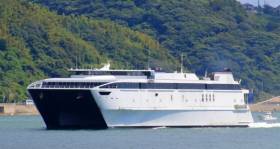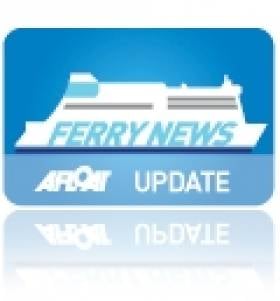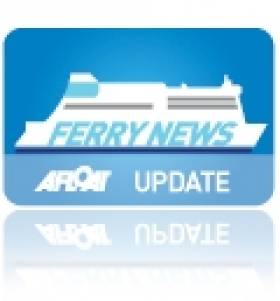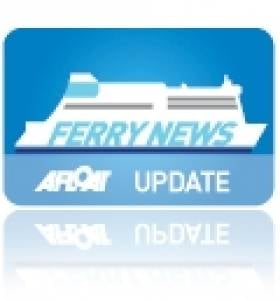Displaying items by tag: Jonathan Swift
A former Irish Sea fast ferry which operates from Spain, will this summer link Barcelona to Alcudia, Mallorca with Ciutadella, Minorca thanks to Palma-based operator, Baleària.
As Majorca Daily Bulletin reports, the ferry company unveiled plans for the route using the Australian-built Cecilia Payne. The vessel is named after the British–American astrophysicist.
Between 1999 and 2018 the catamaran craft custom-built for Irish Ferries served as Jonathan Swift on the Dublin-Holyhead route.
On its entry into service in July 1999, Jonathan Swift increased Irish Ferries' passenger capacity on the Dublin-Holyhead route by 73% and its car capacity by 50%.
The fastferry has spent its entire career on this route (until sold to Balearia in 2018), operating alongside the company's conventional ferries.
The craft which has a capacity for 800 passengers and 200 cars.
Afloat.ie adds the 'Swift' was replaced by another fast-ferry the Dublin Swift which in April this year resumed fast-ferry crossings on the Ireland-Wales route.
The successor fast-ferry took on the name of 'Dublin Swift' as used by Irish Ferries to market the Jonathan Swift.
Irish Ferries Former 'First' Fast Ferry Jonathan Swift Departs On Delivery Voyage to the Mediterranean
#FerryNews - Irish Ferries former first fastferry, Jonathan Swift departed Dublin Port today under new name Cecilia Payne for Spain, a day after a larger replacement craft Dublin Swift took over Dublin-Holyhead sailings, writes Jehan Ashmore.
In January Irish Continental Group (ICG) parent company of Irish Ferries announced that it was to sell the high-speed craft (HSC) to Balearia Eurolineas Maritimas S.A. for an agreed consideration of €15.5 million.
Jonathan Swift is an Austal-Auto Express 86m catamaran which spent a career spanning almost two decades on the core Ireland-Wales route when launched into service in 1999. The 800 passenger/200 car catamaran built by Austal Ships Pty, Australia, became the first fast-ferry ordered by ICG.
At a ceremony in 1999 held at Dublin Ferryport Terminal 1, the high-speed craft (HSC) Jonathan Swift was christened by Cecilia Larkin, then the partner of then Taoiseach Bertie Ahern.
During the past 18 years, the craft marketed as the 'Dublin Swift' operated crossings in just 1 hour 49 minutes. When introduced, the HSC operated alongside cruiseferry Isle of Inishmore which was replaced in 2001 by larger conventional tonnage in the form of Ulysses. In more recent years the flagship was joined by the chartered-in ropax Epsilon.
Departures today of both HSC took place in the afternoon and around ten minutes appart from the capital. This involved Dublin Swift (ICG acquired in 2016 and subsequently chartered overseas), first to pass the Kish Bank Lighthouse and bound for Wales. Astern, Cecilia Payne likewise set a similar course until rounding the lighthouse and then headed for the Bay of Biscay. The next port call is La Coruña in Galicia, northern Spain and eventually the Mediterranean where new owners Balearia await delivery.
When Cecilia Payne debuts in the Mediterranean on 1 June, it is thanks to the 35 knot capable catamaran that reduced sailings times will be made available on two routes: The Dénia (mainland)-Ibiza route and Ibiza-Palma, each taking only 2 hours to complete.
The craft's name of Cecilia Payne has been chosen by Balearia in recognition of the famous Anglo-American astronomer and astrophysicist. She was honoured for her work on the stars and as the first woman to teach at the famed Harvard University.
You Can take the 'Jonathan' Out of Dublin But Not the 'Swift'
#FerryNews - Dublin Swift, the marketing name Irish Ferries use for Jonathan Swift which has been sold to Spanish operators, has been put to use again albeit as the new name given to a replacement high-speed craft, writes Jehan Ashmore.
The sucessor HSC, Westpac Express is to take on the name Dublin Swift at Harland & Wolff's Belfast Dry Dock, having entered the facility yesterday afternoon. The HSC had been on charter to the US Military Sealift Command since Irish Ferries parent Irish Continental Group (ICG) acquired the craft in June 2016. The craft had been flagged to the US but has changed to Cyprus.
The vehicle carrying catamaran HSC built by Austal Ships Pty, Fremantle, western Australia, to their in-house 101m Auto-Express design was redelivered to ICG at the end of November 2017.
Afloat has monitored HSC Westpac Express since arrival in Belfast Port two months ago, having made a stopover call to Holyhead. Invariably, this involved berthing trials prior to taking up service with a scheduled introduction on the Dublin-Holyhead route in April.
On arrival in Belfast, the 2001 built HSC berthed at H&W's Ship Repair Quay adjacent to Belfast Dry Dock to undergo internal refurbishment and maintenance. Work continues to convert the HSC from military requirements (included armoured vehicles) to civilian use. This will enable a refurbishment programme to bring the craft up to Irish Ferries standards.
When Dublin Swift enters service next month, the HSC will bring increased capacity on the Dublin-Holyhead route in partnership with Ulysses. The flagship which is also Cypriot flagged operates with the chartered-in ropax Epsilon which provides more freight-orientated capacity.
The charter of Epsilon will expire in November this year, though ICG has two further one-year options on the Italian flagged 'no-frills' marketed ferry which also serves at weekends on Dublin-Cherbourg round-trips.
Epsilon had previously occupied Belfast Dry Dock for refit. On completion, the ropax resumed service last month albeit with a delayed sailing, firstly on the France route. This was followed by weekday operated sailings on the Wales route.
Jonathan Swift in 1999, became the first fast-craft ferry for Irish Ferries. The custom-built HSC having made the delivery voyage via the Suez Canal from the same Austal yard but based on their 86m Auto-Express design. Due to the marketing name (painted on the hull: see story) of the craft for almost the past two decades, the fastferry has also became known as the 'Swifty'.
In more recent years, HSC Jonathan Swift, became the last fast-ferry remaining on Ireland-UK services, with exception albeit of seasonal operated sailings linking the Isle of Man. It was during the 1990's that the heyday of fast-ferries made their presence on the Irish Sea, in particular services through Belfast.
Dublin Swift's most direct rival came in the form of the High Speed Sea-Service (HSS) Stena Explorer until the Dun Laoghaire-Holyhead route closed with the final season ending in 2014.
The move by Stena Line to abandon the route led to the operator consolidating existing services on the Dublin-Holyhead route that began in 1995. Currently, sailings are by Stena Superfast X while routemate, Stena Adventurer is also in dry-dock for annual refit overhaul. Taking on relief duties is ropax Stena Horizon.
Irish Ferries Fast-Craft Sailings Cancelled
#SailingsCancelled - Due to adverse weather forecast on the Irish Sea for today (Friday 22 March), Irish Ferries have cancelled ALL Jonathan Swift 'fast-craft' sailings.
RE: Friday 22 March 2013
Due to adverse weather forecast on the Irish Sea for Friday 22 March, all Jonathan Swift fast craft sailings have been cancelled.
Ex Dublin 08.45HRS / 14.30HRS
Ex Holyhead 11.50HRS /17.15HRS
RE: Saturday 23 March 2013
Due to adverse weather forecast on the Irish Sea for Saturday 23 March, all Jonathan Swift fast craft sailings are 'Yet to be Confirmed'
EX Dublin 08.45HRS / 14.30HRS
EX Holyhead 11.50HRS / 17.15HRS
All passengers booked on these sailings will be accommodated on the Ulysses cruise ferry sailings as follows
Dublin to Holyhead 08:05/20:55
Holyhead to Dublin 02:40/14:10
For further information please call 0818300400 in Ireland / 08717300400 in the UK
NOTE: In addition to any further 'updated' sailing information available from the Irish Ferries 'FerryCheck' service by visiting this LINK.
The 162,000 kms ‘Swifty’ Returns to Service
#DublinSwift- Jonathan Swift, Irish Ferries fastferry returned fresh to the Dublin-Holyhead service this week, following annual drydocking maintenance in Birkenhead, writes Jehan Ashmore.
- The central corridor route, which is a distance of 60 nautical miles (111 Kms) takes Jonathan Swift only 1 hour 49 minutes while running at up to 40 knots (80kph). So with each crossing, the Dublin Swift, (her marketing name), consumes 15 tonnes of marine diesel oil and in every year she clocks up an impressive total of 162,000 kms.
As previously reported, the Irish Ferrries fleet took in turn annual dry-docking at Cammel Laird, Birkenhead, where the Austal Auto-Express 86m built catamaran craft completed in Fremantle, western Australia, became the last vessel to receive work out of the company's other Irish Sea vessels, flagship Ulysses and cruiseferry Isle of Inishmore.
Now that Isle of Inishmore is back running Rosslare-Pembroke Dock sailings, previously covered by French routes cruiseferry, Oscar Wilde, which is currently undergoing overhaul in Birkenhead.
Oscar Wilde, a former Scandinavian overnight ferry, is scheduled to launch 2013 sailings, firstly Rosslare-Cherbourg on 27 February followed by the peak-season Rosslare-Roscoff route on 10 May.
Not a 'Fast-Ferry' to Be Seen on the Irish Sea
#DublinSwift – The are currently no fast-ferries operating at all on the Irish Sea, not due to bad weather, but for the annual refit of Jonathan Swift, the only such craft running throughout the year, on Irish Ferries Dublin-Holyhead route, writes Jehan Ashmore.
Irish Ferries which markets the fast-craft as the Dublin 'Swift' is currently undergoing maintenance at the Cammell Laird dry-dock facility, Birkenhead. Her brief absence from the route started during the week, however she to resume service on Tuesday 5 February with the 08:45 sailing from Dublin Port.
Also berthed in Birkenhead, is Irish Ferries cruiseferry Isle of Inishmore, which too is undergoing annual refit. As previously reported on Afloat.ie, the flagship Ulysses, the largest ferry on the Irish Sea, was also refitted at the same facility recently, as she returned earlier this week to the Dublin-Holyhead service.
So where are the rest of the fast-ferries?...well, there's three to be found in 'hibernation' mode. Firstly, facing opposite Birkenhead, the Isle of Man Steam Packet Company's fast-ferry Manannan is laying over for the winter in Liverpool docks, until required to operate routes to Douglas in the Spring.
Stena Line's HSS Stena Explorer is in lay-up at her berth in the inner harbour in Holyhead, where she is to remain until resuming her seasonal-only service starting on 22 March and running through the peak-season until September.
Finally the third fast-ferry, P&O's Express is berthed alongside Donegall Quay, Belfast, though this is not where she operates from, but on the seasonal Larne-Troon service.
Also to be found in Belfast is the laid-up HSS Stena Voyager, one of a trio of HSS 1500 series built in Finland. She became redundant more than a year ago following change of Scottish ferryport from Stranraer to Cairnryan, from where a pair of 'Superfast' ferries operate the North Channel route to Belfast.
Irish Ferries Fleet Start Dry-Docking Schedule
#FERRY NEWS- This morning Irish Ferries Dublin-Holyhead route cruiseferry Ulysses departed for Birkenhead, on the Mersey, for annual maintenance at the Cammell Laird dry-docks facility, writes Jehan Ashmore.
In place of Ulysses, the Isle of Inishmore has taken up her sailing roster, as previously reported on Afloat.ie, the ro-pax ferry had last night completed her own additional sailings to cope with increased demand over the festive season.
Isle of Inishmore which normally operates the Rosslare-Pembroke Dock route, will too be dry-docked for 15 days at the same facility, releasing Ulysses which is expected to return to service on 14 January, with the 08.50hrs sailing to Holyhead.
When the 'Inishmore' is off service, she will be joined by the central-corridor route's fast-craft Jonathan Swift, albeit in a separate dock, remaining there until 2 February.
Once work on Isle of Inishmore is completed, she is planned to vacate the dock on 30 January, which in turn will allow cruiseferry Oscar-Wilde to enter the next day, for her period of routine maintenance.
This will allow Isle of Inishmore to return to the Rosslare-Pembroke Dock route, where the Oscar Wilde is currently operating. The French routes ferry Oscar Wilde will finally return to launch the Cherbourg route on 27 February, followed by high-season sailings to Roscoff beginning in May.
Irish Ferries 'Flagship' Returns to Dublin Route
#FERRIES - Ulysses arrived fresh from refit on the Dublin-Holyhead route yesterday after annual dry-docking at Cammell Laird, Birkenhead, writes Jehan Ashmore.
As previously reported on Alfoat.ie the Irish Ferries 'flagship' sailings on the central corridor route (also served by Jonathan Swift) where relieved by Isle of Inishmore earlier this month.
Isle of Inishmore departed Dublin Port last evening and headed to Liverpool Bay, where she anchored overnight. She docked at Cammell Laird this afternoon, where she too is to undergo annual overhaul.
With Isle of Inishmore off service on her usual Rosslare-Pembroke Dock route, the company's French routes vessel, Oscar Wilde is maintaining sailings.
On 19th February, the Oscar Wilde resumes service on Rosslare-Cherbourg route and she will also re-open the seasonal-only operated route to Roscoff which starts in May.
Ireland Battered by Storm-Force Winds
#WEATHER - Ireland has been warned to brace for further strong winds set to sweep across the country today (4 January),
The Irish Times reports. Winds reaching near hurricane speeds have affected coastal communities in the north and northwest, peaking at a remarkable 168km/h in Donegal.
Thousands of euro worth of damage was caused when the roofs of traditional thatched cottages at Cruit Island in west Donegal were blown away.
But the west and east have also been hard hit, with storm-force gales exceeding 100km/h uprooting trees and disrupting electricity supply.
As previously reported on Afloat.ie, ferry services on the east coast have been severely affected. Irish Ferries cancelled two fast ferries from Dublin to Holyhead yesterday, and today's early Jonathan Swift sailings between Dublin and Holyhead were also cancelled.
Met Éireann expects wind speeds to be lower today, but could still reach 90-120km/h in some areas.
The Irish Times has much more on the story HERE.
Strong Winds Cancel Central Corridor Fast-Ferry Sailings
Stena Line's Dublin-Holyhead sailings are on schedule in addition to services on the Rosslare-Fishguard, Belfast-Stranraer (incl. HSS sailings) and Belfast-Liverpool. P&O's Dublin-Liverpool and North Channel Larne-Cairnryan route are also on schedule.
On the Celtic Sea, Fastnet Line's Cork-Swansea is unaffected as there are no sailings on Monday's, Tuesday's and Wednesday's during this month and November. The next sailing is this Thursday from Cork at 20.30hrs and returning Swansea on Friday at 21.30hrs.
According to Met Eireann, this afternoon will be extremely windy, especially across the southern half of the country, with southwest gusts of between 90 and 120km/h. For more detailed and updated weather forecasts visit www.met.ie




































































